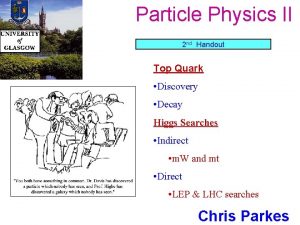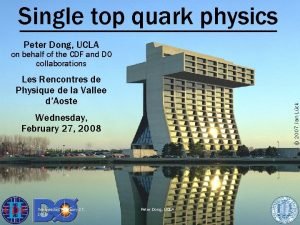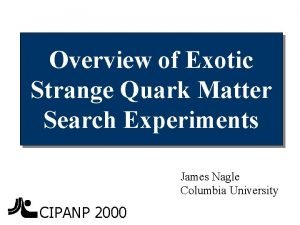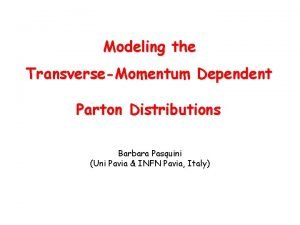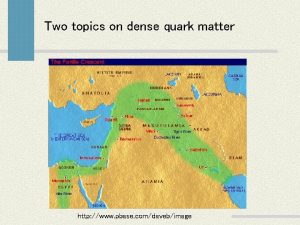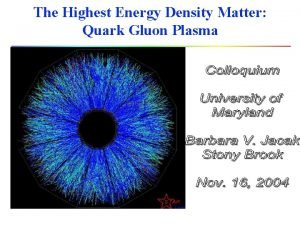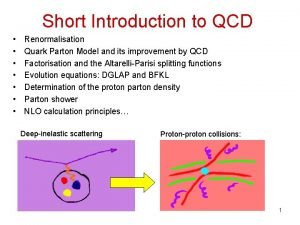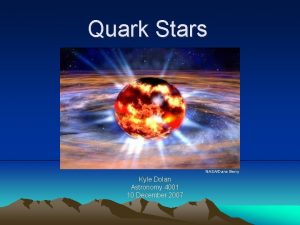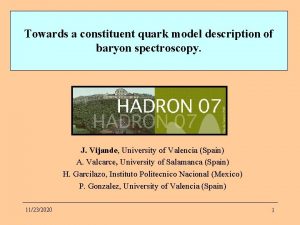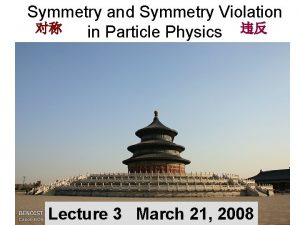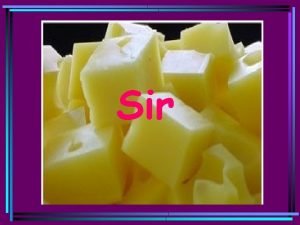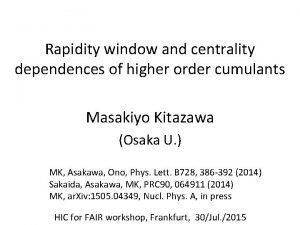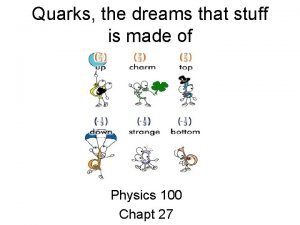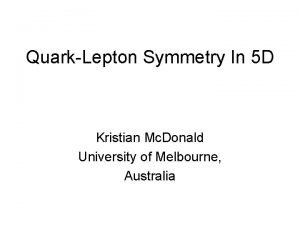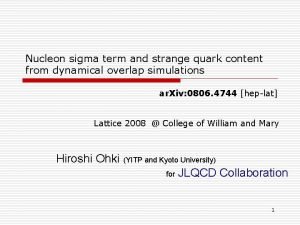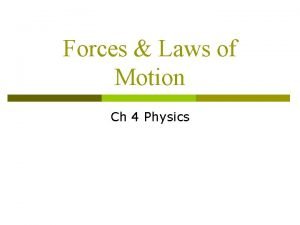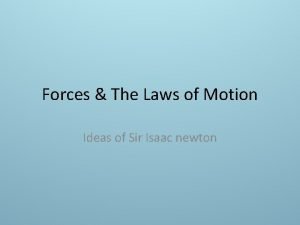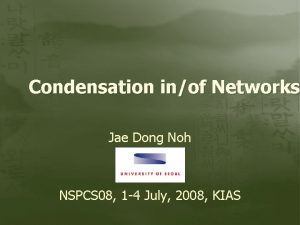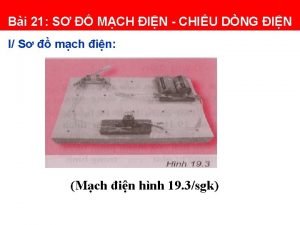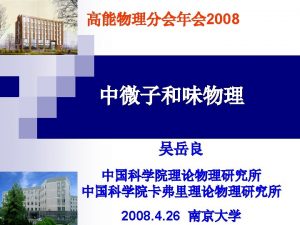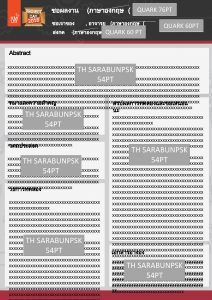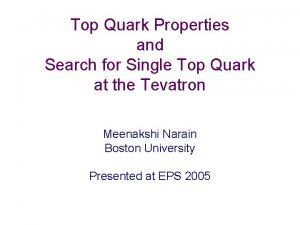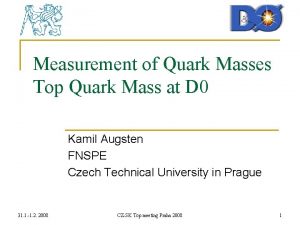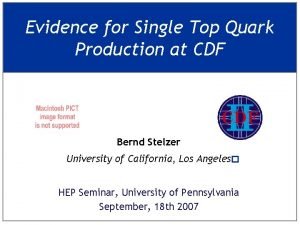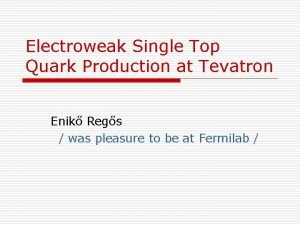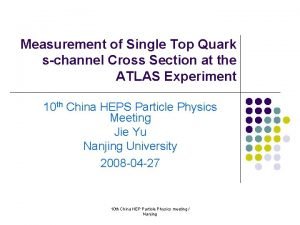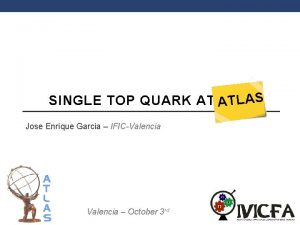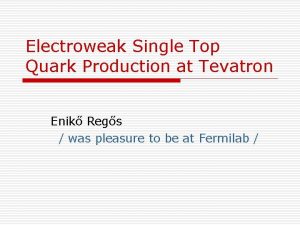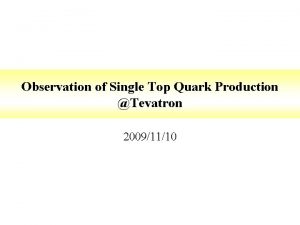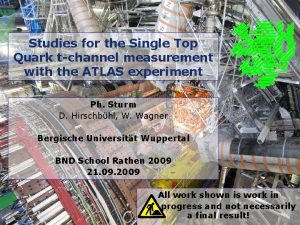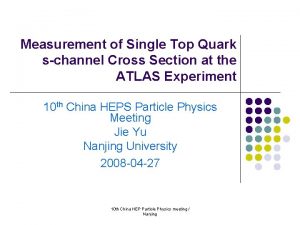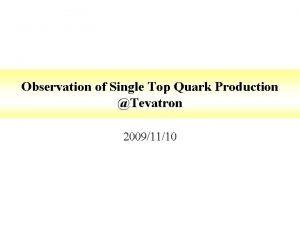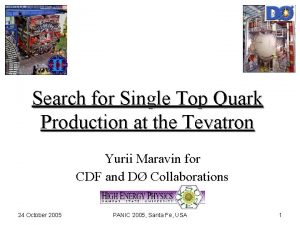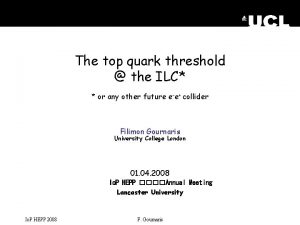Single top quark physics Peter Dong UCLA on




























- Slides: 28

Single top quark physics Peter Dong, UCLA on behalf of the CDF and D 0 collaborations © 2007 Jan Lück Les Rencontres de Physique de la Vallee d’Aoste Wednesday, February 27, 2008 Peter Dong, UCLA

The Tevatron n World’s highestenergy particle accelerator in operation Two multipurpose particle detectors, CDF and D 0 The only place in the world to study top quarks (for now) Wednesday, February 27, 2008 Peter Dong, UCLA 2

Top pair production Electroweak single top production t-channel 1. 98 ± 0. 21 pb Vtb s-channel Top pair 0. 88 ± 0. 07 pb 6. 7 ± 0. 8 pb n Vtb Top quarks are predominantly produced Electroweak single top production allowsin pairs by measurement the strong force – Direct of CKM matrix element |Vtb| – Can study properties like mass, charge, W helicity Measurement of top polarization NLO cross-sections at Mtop=175 Ge. V/c 2 --- B. W. Harris et al, hep-ph/0207055; Z. Sullivan, hep-ph/0408049 Wednesday, February 27, 2008 Peter Dong, UCLA 3

Sensitivity to new physics n Single top has similar experimental challenges to WH – WH is preferred channel for low-mass Higgs production at the Tevatron – Have to find single top to find Higgs in this channel! WH production ~0. 2 pb at 120 Ge. V Also sensitive to heavy W′, flavorchanging neutral currents, Kaluza. Klein heavy Wkk, … Wednesday, February 27, 2008 Peter Dong, UCLA 4

Experimental challenge n Top quark pairs produce a final state with a lepton, missing transverse energy, and four jets --- a distinct signature single top production – Signal : background of about 4 : 1 n Single top production, with a smaller cross section and two fewer jets, is much harder to find – Signal : background of about 1 : 15 – A simple counting experiment is impossible! Wednesday, February 27, 2008 Peter Dong, UCLA top pair production 5

Although searching for something so tiny may seem hopeless… …We are still sensitive to the effects if we know what to look for Wednesday, February 27, 2008 Peter Dong, UCLA 6

Data Signal/Background Monte Carlo Result Analysis Event Selection General analysis method Apply MC Corrections Template Fit to Data Cross Section Wednesday, February 27, 2008 Peter Dong, UCLA Sophisticated technique to separate signal from background: Analysis Decision tree (D 0) Technique Likelihood function (CDF) Matrix element (CDF, D 0) Neural network (CDF, D 0) Signal Background Discriminant 7

D 0 single top search in 910 pb-1 Wednesday, February 27, 2008 Peter Dong, UCLA 8

Event selection and background estimate n n Exactly one tight lepton Large missing transverse energy Two to four jets At least one b-tagged jet – Neural net tagger reduces mistag rate – Apply tag rate functions, derived in data, to Monte Carlo n n Estimate large W+jets background by applying heavy flavor fraction to pretagged data, then applying tagging rate Use events with non-isolated leptons as multijet model Wednesday, February 27, 2008 Peter Dong, UCLA 9

Matrix element method n Calculate probability density of an event resulting from a given process Phase space factor: Integrate over unknown or poorly measured quantities Inputs: lepton and jet 4 -vectors – no other information needed! n n n Parton distribution functions Matrix element: Different for each process. Leading order, obtained from Mad. Graph Transfer functions: Account for detector effects in measurement of jet energy Uses full kinematic information of an event to discriminate signal events from background events Calculate probability densities for s- and t-channel, Wbb, Wcj, Wgg, tt-bar (3 jet bin) Use matrix element probability densities to create a likelihood ratio: signal / (signal + background) Wednesday, February 27, 2008 Peter Dong, UCLA 10

Bayesian neural network n n n Neural networks are trained on Monte Carlo to discriminate signal from background A Bayesian neural network is a weighted average of many networks Protected against overtraining Hidden Nodes Input Nodes Wednesday, February 27, 2008 Output Node t-channel Peter Dong, UCLA Wbb 11

Boosted decision tree n n Start with large number of input variables (49) Optimize series of binary cuts in Monte Carlo – Automatically finds “interesting” variables n n Sort events by output purity Create series of “boosted” trees by reweighting based on misclassified events Wednesday, February 27, 2008 Peter Dong, UCLA 12

Results Matrix element method Bayesian neural network Measured cross section: +1. 6 4. 8 − 1. 4 pb Wednesday, February 27, 2008 +1. 6 4. 4 − 1. 4 pb Peter Dong, UCLA Boosted decision tree +1. 4 4. 9 − 1. 4 pb 13

Sensitivity Matrix element method Bayesian neural network Boosted decision tree Expected sensitivity: Expected p-value: 0. 03 (1. 9 s) 0. 016 (2. 2 s) 0. 019 (2. 1 s) Observed p-value: 0. 00081 (3. 2 s) Wednesday, February 27, 2008 0. 0008 (3. 1 s) Peter Dong, UCLA 0. 00035 (3. 4 s) 14

D 0 combination and |Vtb| Combine results with best linear unbiased estimator (BLUE) method Measured cross Expected sensitivity: section: 0. 011 (2. 3 s) n 4. 7 ± 1. 3 pb Observed p-value: 0. 00014 (3. 6 s) Derive a limit on |Vtb| based on boosted decision tree result n Assume |Vtd|2 + |Vts|2 << |Vtb|2 n |Vtb| > 0. 68 at 95% C. L. Wednesday, February 27, 2008 Peter Dong, UCLA 15

CDF single top search in 1. 5 fb-1 Wednesday, February 27, 2008 Peter Dong, UCLA 16

Background estimate n n Similar selection to D 0, but with tighter QCD veto Use displaced secondary vertex to tag a b-jet Scale W + heavy flavor background from fit in the W + 1 jet bin Model non-W background with jet fakes and inverted lepton cuts CDF Run II Preliminary Predicted event yield with 1. 5 fb-1 s-channel 23. 9 ± 6. 1 t-channel 37. 0 ± 5. 4 Single top 60. 9 ± 11. 5 tt 85. 3 ± 17. 8 Diboson 40. 7 ± 4. 0 Z + jets 13. 8 ± 2. 0 W + bottom 319. 6 ± 112. 3 W + charm 324. 2 ± 115. 8 W + light 214. 6 ± 32. 2 Non-W Total background 1042. 8 ± 218. 2 Total prediction 1103. 7 ± 230. 9 Observed Wednesday, February 27, 2008 44. 5 ± 17. 8 Peter Dong, UCLA 1078 17

Jet flavor separator n n Use a neural net to separate jets from bquarks from light-quark jets Produces a continuous output – not a cut Other CDF analyses use this variable to purify their sample Improves sensitivity by 10— 20%! Wednesday, February 27, 2008 Peter Dong, UCLA 18

Heavy flavor calibration n n Calibrate W + heavy flavor in W + 1 jet data Three-parameter fit to bottom/charm/light templates of jet-flavor- separating distributions Correct for EWK/Top contributions Cross-check light flavor yield with prediction from mistag matrix KHF=1. 4 ± 0. 4 Wednesday, February 27, 2008 Peter Dong, UCLA 19

Non-W background n n Build non-W model from data Invert non-kinematic lepton identification cuts Data is superposition of non-W and W+jets contribution Do likelihood fit to data Electrons + 2 Jets Muons + 2 Jets Signal Region Residual non-W: 5. 1% 2. 0% 1. 4% 0. 6% W+Jets Wednesday, February 27, 2008 non-W Signal Region Peter Dong, UCLA W+Jets 20

Multivariate likelihood function n Multivariate binned likelihood combines several sensitive variables into a single variable Pioneered at LEP Seven variables in this analysis Nsig Nbkg Wednesday, February 27, 2008 Peter Dong, UCLA 21

Likelihood Function Analysis Unit area Background Wbb ttbar Wednesday, February 27, 2008 Signal tchan schan Background Wbb ttbar Signal Background tchan schan Signal tchan schan Wbb ttbar Peter Dong, UCLA 22

Matrix element method Similar approach for both experiments n CDF also includes jet flavor separator in discriminant to reduce contamination from light flavor jets: n Wednesday, February 27, 2008 Peter Dong, UCLA 23

Matrix element cross-check n n Check the discriminant in the orthogonal untagged region to show that we model the data well Region is dominated by light jets --- validates our modeling of W + jet kinematics Wednesday, February 27, 2008 Peter Dong, UCLA 24

Results Likelihood function Matrix element Measured cross section: +1. 3 2. 7 − 1. 1 Wednesday, February 27, 2008 +1. 2 3. 0 − 1. 1 pb pb Peter Dong, UCLA 25

Sensitivity Likelihood function Matrix element Expected sensitivity: Expected p-value: 0. 002 (2. 9 s) 0. 001 (3. 0 s) Observed p-value: 0. 003 (2. 7 s) Wednesday, February 27, 2008 0. 0009 (3. 1 s) Peter Dong, UCLA 26

Measurement of |Vtb| results n Assume: – Flat prior in |Vtb|2 – 0 < |Vtb|2 ≤ 1 – |Vtd|2 + |Vts|2 << |Vtb|2 n Combined measurement and limit in progress |Vtb|= 1. 02 ± 0. 18 (experiment) ± 0. 07 (theory) Wednesday, February 27, 2008 Peter Dong, UCLA 27

Conclusion Measuring the single top cross section is very challenging! n Multivariate analysis techniques are essential to increase sensitivity n Both CDF and D 0 have seen evidence of single top quark production n First direct measurement of |Vtb| with 18% experimental uncertainty n Keep on collecting data and improving our analyses! n Wednesday, February 27, 2008 Peter Dong, UCLA 28
 Ding dong ding dong ding dong the bell is ringing
Ding dong ding dong ding dong the bell is ringing Top quark decay
Top quark decay Physics wordle
Physics wordle Peter dong
Peter dong Quarks
Quarks Quark names
Quark names Quark model
Quark model Quark gluon
Quark gluon Quark gluon
Quark gluon Quark parton model
Quark parton model Quark astronomy
Quark astronomy Quark gluon
Quark gluon Quark names
Quark names Constituent quark model
Constituent quark model A charm quark has a charge of approximately
A charm quark has a charge of approximately Caprodur sir
Caprodur sir Quark gluon plasma
Quark gluon plasma 6 types of quarks
6 types of quarks Quark lepton symmetry
Quark lepton symmetry Sigma quark composition
Sigma quark composition Quark matter 2022
Quark matter 2022 Derek leaves his physics book on top of a drafting table
Derek leaves his physics book on top of a drafting table Forces and the laws of motion problem b
Forces and the laws of motion problem b Ding dong hypothesis
Ding dong hypothesis Dong nao jin maths
Dong nao jin maths Hệ thống thông tin trong logistics
Hệ thống thông tin trong logistics Dong quai nedir
Dong quai nedir Jae dong noh
Jae dong noh Sơ đồ mạch điện chiều dòng điện
Sơ đồ mạch điện chiều dòng điện

